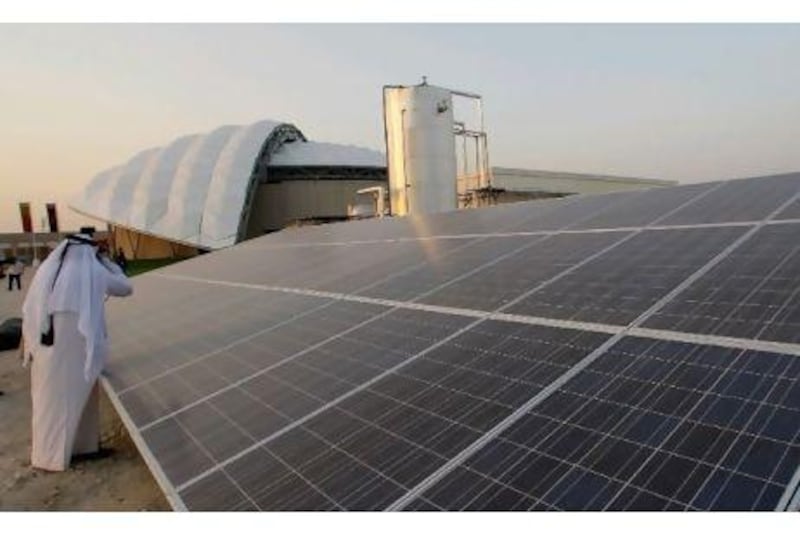DOHA // When an Irishman told the patrons of a Limerick pub last year that Qatar's bid to host the World Cup finals in 2022 had a good chance of success, the locals laughed.
The patrons, of course, were not alone in considering Qatar's bid to host the world's largest football tournament with a wry smile. But when the tiny desert emirate beat off competition from Australia, Japan, South Korea and the United States in December, football fans all over the world sat up and took notice.
But the Irishman, Eamonn Phillips, had not based his prediction on a whim. As the regional general manager for Mercury Middle East, an engineering contractor headquartered in Ireland, he was involved with a project to show that Qatar was serious about bringing the tournament to the Middle East for the first time.
"They won the World Cup because of it," Mr Phillips said.
The project was the 2022 Doha Showcase Stadium, a 500-seat air-conditioned venue to prove teams and spectators could be kept cool in summer temperatures that can reach 50C. When a technical committee from world football's governing body, Fifa, visited the prototype in September, it seems to have had the desired effect.
Mr Phillips's company installed most of the stadium's mechanical and electrical services. He said: "There were a lot of sleepless nights. We were designing the job as we went along. It allowed so little time in the end that I just don't know how they got it done."
To finish the stadium in three months, labourers and engineers worked through the nights while concerned members of the royal family, including Sheikh Mohammed bin Hamad Al Thani, the emir's son who headed the bid committee, checked on progress with unannounced visits.
The stadium was designed with a retractable roof because Fifa requires World Cup matches to be played in the open air. The roof can be closed for 72 hours before a game to allow air-conditioning units to cool the venue and opened before kick-off. While the game is in play, cooled air continues to blow out from vents placed under the spectators' seats.
The temperature outside the stadium two hours before the Fifa delegation arrived in September was 44¿C and when they visited the pitch it was measured at 23¿C. Fifa guidelines say temperatures above 32¿C put the players at "extreme" risk.
The cooling techniques will have to be integrated into 12 much larger stadiums - nine built from scratch - to host the tournament, posing a much greater challenge for engineers. The venue to host the opening and final matches, Lusail Iconic Stadium, is designed to have an 82,250 capacity, 172 times greater than the prototype.
Saud Aldajah, an expert in thermodynamics at United Arab Emirates University's mechanical engineering department, said after reviewing the bid team's infrastructure proposal that the problem of cooling the venues "needs thorough analysis and calculations since it is a non-steady state transient heat transfer problem".
Mr Aldajah said: "However, after quick calculations and many assumptions, it seems that it will be possible to maintain the stadium within a comfortable temperature range provided that there is adequate number of high-load air-conditioning systems."
The bid says the stadiums will use "environmentally friendly, carbon-neutral technology", such as solar thermal collectors and PV panels. The solar panels are designed to export energy to the power grid when the stadium is not in use so they will create as much energy in the long term as the stadiums use up in short bursts.
Ali Hajiah, an associate research scientist at the Kuwait Institute for Scientific Research's buildings and energies technology department, said: "They might be able to do a low-energy construction, but it's going to be really difficult to achieve net-zero, especially if we consider desalination of the water" for the grass.
The builders of the prototype recently learnt just how unforgiving the Gulf's sun can be. When the irrigation system was turned off for three days, the grass withered and died, and had to be re-grown.
They will need to dedicate a "huge area" for solar panels and it will have to be topped up with energy from conventional sources, such as gas and oil, Mr Hajiah said.
"The efficiency of the existing solar panels will vary when they are installed in the harsh weather conditions of the Gulf."
Tommy Skinner, the British project manager for ESG Middle East, the company that did most of the construction for the prototype, said the solar cells currently used, which can heat water up to 200C are second-generation technology, adding: "It should be third or fourth generation by the time the World Cup comes around".
The stadium designs include one in the shape of a seashell, another in the shape of a traditional dhow and another with a "media facade" surrounding the entire exterior to act as a giant screen. Nine of the new venues are designed to be built with modula" components that can be scaled down or shipped off to developing countries after the tournament.
In addition to the stadiums, Qatar will have to build air-conditioned training grounds, transport systems and entertainment facilities to host the games. The cost of developing the infrastructure will be huge but, as the showcase stadium proves, the government is willing to dig deep into its pockets.
Contractors exceeded their initial budget of £25 million (Dh150 million) in order to finish the venue on time.
"I think it's a big challenge, but I think they're up to it," said Mr Phillips, who was greeted with disbelief when he returned to the bar in Limerick after the result was announced. "I think it's good for football to have it in the Middle East."





